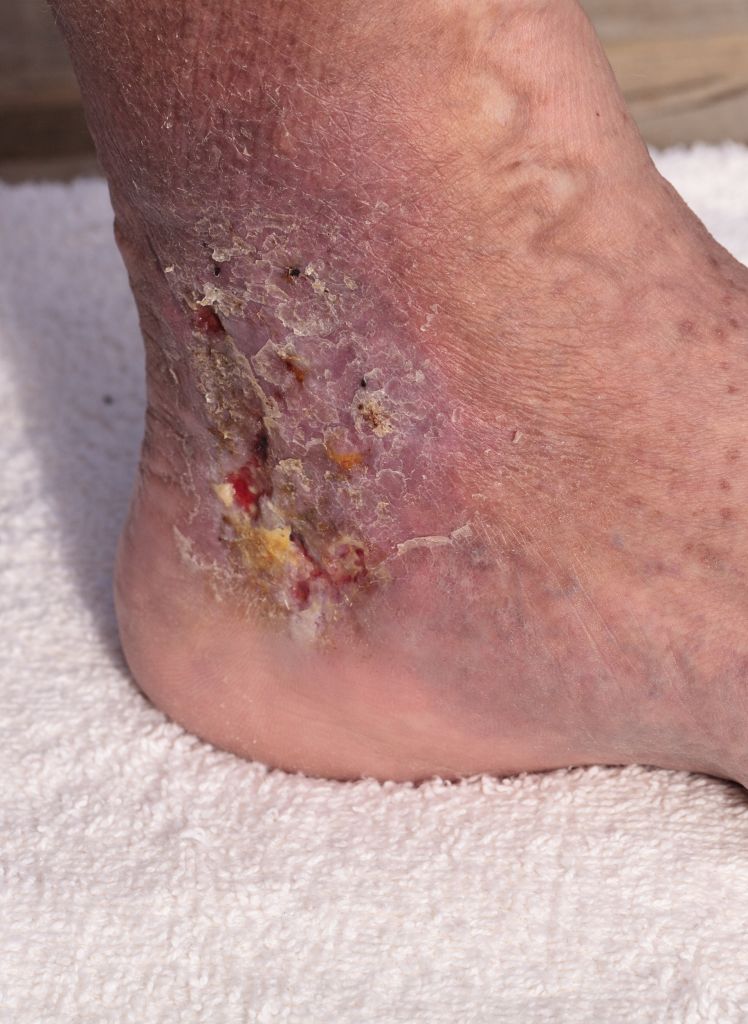Bacteria and Skin Infections

Did you know your skin is the largest organ of your body, and it serves as your front-line defense against infection and disease. If your body was a medieval city, your skin would be the great, big wall that surrounds and protects the inhabitants against marauders and attackers from other kingdoms. Because of this, your skin is often the first thing bacteria encounters when it attempts to invade your body.
More...
Medieval castle walls and ramparts were made as strong as possible, and your skin is very strong as well. However, even the healthiest skin can give in to a constant onslaught of bacteria, or a single exposure to an especially powerful bacterium.
This can result in a skin infection.
If your immune system, of which your skin is a principal part, does its job properly, your bacterial skin infection will eventually be turned away.
When the infectious bacteria are left untreated, or your immune system is otherwise impaired or weak, a mild infection can become serious.
It can permeate your skin and enter your bloodstream in some cases, doing serious damage.
Let's look at a few of the more common bacterial skin infections, how they are caused, and how you can treat these unwelcome invaders.
Common Skin Infections Caused by Bacteria
Impetigo
Impetigo is highly contagious, and usually occurs on young children and infants around the face, neck or hands. It may also develop around the diaper area in infants and toddlers. Telltale signs are red sores that burst easily, leaving a yellow crusty film.
Skin lesions and an itchy rash may also accompany this bacterial infection. The rash begins as small sores, which first appear near the mouth. Within a few days, these sores become blisters that are full of pus that may ooze out until the blisters eventually burst and crust over. Impetigo can be caused by an injury to the skin, direct, physical contact with someone who has impetigo, insect bites or animal bites.
Children between the ages of 2 and 6 are prime candidates for this condition, and warm, humid weather, poor hygiene, diabetes and other skin conditions raise the risk as well. At-home treatments include washing the infected area several times per day or applying an antibacterial wash. A topical or oral antibiotic may be prescribed, and this condition usually goes away within 2 or 3 weeks when treated properly.

When left untreated, impetigo can take a long time to heal and may lead to secondary infections.
Most physicians can diagnose impetigo by merely looking at your rash. It has a very distinct appearance and is easy to identify without invasive testing.
If you are given oral antibiotics to treat your impetigo, you may experience some side effects from the medication. The most common side effects are gastrointestinal issues, such as nausea and vomiting, diarrhea, and abdominal pain.
Although impetigo is extremely contagious, it is possible to reduce your risk of contracting it.
You should always practice good hygiene, including washing your hands with warm water and soap frequently. Taking showers or baths can reduce the number of bacteria on your skin, and washing clothes and linens regularly can also reduce exposure.
Some possible secondary conditions include cellulitis, an infection of the tissues beneath the skin, and sepsis, which is a critical condition in which the bloodstream becomes infected. Very rarely, impetigo patients develop an issue known as post-streptococcal glomerulonephritis, which results in blood vessel inflammation within the kidneys.
Cellulitis
This is a rather common bacterial skin infection and can also has the potential to be severe. It also affects the soft tissue directly underneath your skin. If you have a cut, wound or other break in your skin, bacteria can enter and cause this condition. Usually painful, cellulitis appears as a swollen, red area and may feel tender and the skin can seem to put off heat, being hot to the touch. This bacterial skin infection can pop up anywhere but is usually confined to the lower legs.
Inflammation or swelling of the eyelid or the areas around the eye, as well as a reddening of the eye, are both very obvious symptoms that a person may be experiencing cellulitis.
It is especially common with children, and the swelling may be so extreme that it makes it difficult for the sufferer even to open their eyes. If this symptom becomes severe, it can even go into the brain or the spinal cord, which can be very dangerous, as that it can cause blood clots to form.

Infection cellulitis on the skin of an ankle caused by phlebitis and blood clots in the vein
Left untreated this can be a life-threatening condition. Diabetes, trauma to the skin, circulatory problems, skin disorders such as psoriasis and eczema, and liver disease put you at risk for cellulitis. Caught early, taking antibiotics for 14 days gives you a good chance of curing the problem.
When a person is suffering from cellulitis, another symptom is that sores within the infected area may often blister, excreting a pus-like liquid. This fluid can best be described as a rather clear liquid, with a tinge of yellow.
When cellulitis takes hold, these blisters begin to form, and there can be a buildup of bacteria, along with dead white blood cells. In extreme cases, the pus can be drained from the body by a medical professional making an incision to allow the liquid to leak out. This procedure is often referred to as “lancing”.
Antibiotics may also be prescribed to help with clearing up the infection.
Your doctor may also prescribe intramuscular antibiotics or use an IV if the infection is severe. Washing injured skin immediately and practicing smart personal hygiene will reduce your risk of developing cellulitis. In rare cases, surgery may be required.
Boils
A boil, also called a furuncle, is caused by a fungal or bacterial infection of your hair follicles. The affected follicle can be located anywhere on your body. The infection begins as nothing more than a small red lump which may be tender to the touch. As the boil fills with pus a skin abscess develops, and the boil may even burst.
Boils typically appear where sweat and friction are present. When boils cluster together, they can form a carbuncle. Carbuncles are swollen, red painful groups of boils that are connected, and located just beneath your skin.
Furuncles become more painful as they grow, and usually go away on their own within a few days. Carbuncles are more serious, and may sometimes be accompanied by a high fever, exhaustion and a feeling of weakness.
The risk of scarring with carbuncles is moderately high.
Diabetes, medications, HIV and other diseases which weaken the immune system, as well as eczema, psoriasis and acne, are common causes of boils and furuncles. Lancing the abscess should only be done by a trained medical professional, and in rare cases, antibiotics may be prescribed.
Leprosy
Leprosy is caused by the Mycobacterium Leprae bacterium. This chronic and progressive bacterial infection attacks the nerves of your extremities, sometimes the upper respiratory tract, or the lining of the nose.

Leprous man during "Week-end de L'ascension-Grand Fête médiévale" in Nogent de Rotrou, France, 15-16.05.2010.
Nerve damage and muscle weakness is often a symptom, as well as skin sores.
Disfigurement or disability is a very real possibility if not treated promptly. Common in subtropical and tropical climates, leprosy has been traced back to 600 BC, and is one of the oldest human diseases in history.
Leprosy is contagious but only through constant and direct contact with the mucus of someone who has been infected. This typically occurs when that person coughs or sneezes around the same individual multiple times, and in close contact.
The incubation period for leprosy is slow acting, and symptoms may not appear for as many as 20 years.
A multi drug therapy for leprosy was developed by the World Health Organization (WHO) and is available free of charge worldwide.
There are also multiple antibiotics used to treat leprosy, including Dapsone, Clofazimine, Minocycline and Ofloxacin.
So as Dr. Dieguez has mentioned there are certain bacteria that can live on our skin every day without causing any signs of infection those bacteria called Staphylococcus and Streptococcus Staphylococcus is a bacterial organism that has been present for ages and centuries it lives on our skin
however with this age of new antibiotics which started happening whenever people develop infections with Staphylococcus from simple cuts antibiotics are introduced and they do kill off most of the bacteria and infection
however a couple of them survive and they mutate and they become resistant to most common antibiotics the penicillin type of antibiotics and here we are with this new scary infection called MRSA
what MRSA is essentially a Staphylococcus that has mutated and became so strong that no regular antibiotic will kill it
MRSA is obviously more prevalent in hospitals in nursing homes however it's no longer just a hospital acquired infection no longer just nursing home acquired infection it can occur anywhere to be honest me and Dr. Dieguez probably have MRSA living on our skin rather than regular Staphylococcus just from being exposed to it in the hospital all the time
scared to say but MRSA or regular Staphylococcus still require a cut were some way they need some way to be introduced into the skin into a deeper layer of the skin to cause infection. .
As found on Youtube


